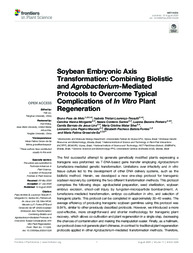Soybean embryonic axis transformation: combining biolistic and Agrobacterium-Mediated Protocols to overcome typical complications of in vitro plant regeneration.
Soybean embryonic axis transformation: combining biolistic and Agrobacterium-Mediated Protocols to overcome typical complications of in vitro plant regeneration.
Author(s): MELO, B. P. de; LOURENCO-TESSUTTI, I. T.; MORGANTE, C. V.; SANTOS, N. C.; PINHEIRO, L. B.; LINS, C. B. de J.; SILVA, M. C. M.; MACEDO, L. L. P.; FONTES, E. P. B.; GROSSI-DE-SA, M. F.
Publication year: 2020
Types of publication: Journal article
Observation
Some of Embrapa's publications are published as ePub files. To read them, use or download one of the following free software options to your computer or mobile device. Android: Google Play Books; IOS: iBooks; Windows and Linux: Calibre.
Access other publications
Access the Agricultural Research Database (BDPA) to consult Embrapa's full library collection and records.
Visit Embrapa Bookstore to purchase books and other publications sold by Embrapa.

